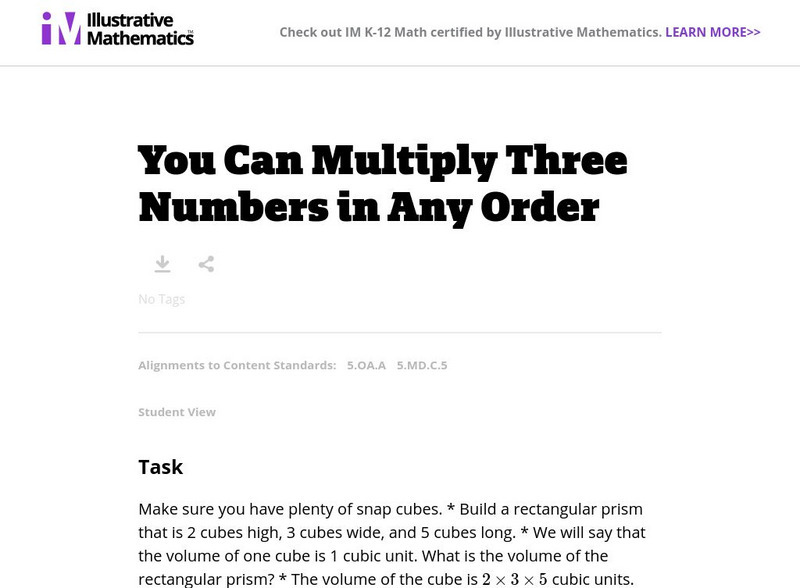Other
Ask Lois Terms: Distributive Property
So, you don't know what the distributive property is. Never fear, just ask Lois! She knows all about the "Properties." Find this definition and others in this site were kids can email questions about math and get answers. Math terms...
Help Algebra
Help algebra.com: Addition Principle
Beginning with a discussion of equivalent equation, this site describes the Addition Principle and how it is used to help solve algebraic equations.
Khan Academy
Khan Academy: Math Patterns 1
Identify arithmetic patterns (including ones in the addition or multiplication tables), and explain them using properties of operations. Students receive immediate feedback and have the opportunity to try questions repeatedly, watch a...
Math Medics
S.o.s. Math: Hyperbolic Functions
This math lesson gives formulas for the hyperbolic trigonometric functions, a very most important property of their version of the Pythagorean Theorem, and it's verification, and many helpful visual aides.
Cuemath
Cuemath: Integers
The term "integer" was adapted in Mathematics from the Latin word "integer", which means intact or whole. Integers are very much like whole numbers, but they also include negative numbers. This article explains the properties of integers...
Science Struck
Science Struck: Uses of Calcium Chloride
Learn about some uses of calcium chloride as a food additive, as a drying agent, for de-icing, in concrete mixes, and for its exothermic properties.
Varsity Tutors
Varsity Tutors: Hotmath: Algebra Review: Opposites
Find a quick, concise explanation of the property of opposites. Several examples are given and clearly explained.
California Institute of Technology
Spitzer Science Center: Ring of Stellar Death
The Ring of Stellar Death captured in this space telescope image features a dying star expelling what appears to be clumpy rings of material, but turns out to be part of a planetary nebula. In addition, a detailed textual overview...
CK-12 Foundation
Ck 12: Elem Math: Selecting the Related Addition Fact
[Free Registration/Login may be required to access all resource tools.] The video describes how to determine which addition fact is related to the given addition problem. The video uses vocabulary of addends and sum. The video is...
Illustrative Mathematics
Illustrative Mathematics: Counting Dots in Arrays
This task aims to show students that there is often more than one way to represent a quantity. This lesson also lays a foundation for students to understand the commutative property of multiplication.
University of St. Andrews (UK)
University of St. Andrews: Brahmagupta
Brahmagupta was a mathematician and an astronomer. He is responsible for the addition and multiplication properties of zero.
Saddleback College
Algebra2 Go: Prealgebra
The resource consists of comprehensive learning tools such as class notes, video lectures, and templates through which students can review prealgebra topics.
University of Nebraska
University of Nebraska: Vectors and Vector Addition
This resource provides an introduction to vectors and their additive properties.
J Coffman
Joseph Coffman's Lecture Notes: Solving Systems of Equations Algebraically
The lesson explores solving systems of equations algebraically. Topics discussed are the elimination method, substitution method, addition property, and special cases. Examples with detailed solutions and an assessment are included.
Oswego City School District
Regents Exam Prep Center: Closure Property
This site gives a very clear discussion on the topic of closure of sets over an operation with many examples.
Illustrative Mathematics
Illustrative Mathematics: 5.md,oa You Can Multiply Three Numbers in Any Order
The purpose of this task is for students to use the volume of a rectangular prism to see why you can multiply three numbers in any order you want and still get the same result. Aligns with 5.OA.A and 5.MD.C.5.
Science Struck
Science Struck: Adding Exponents
Explains how to add exponents as well as other aspects of exponents including positive and negative exponents, rational exponents, zero exponents, power of power, and division of exponents. Includes practice problems with answers provided.
Texas A&M University
Wtamu Virtual Math Lab: Intermediate Algebra: Linear Equations in One Variable
After completing this tutorial, you'll know what a linear equation is and how to solve one using various arithmetic properties. Contains several definitions, problems with step-by-step solutions, and practice exercises. Includes links to...
NumberNut
Number Nut: Carrying Like Addition
Use what you already know about addition to master this skill in multiplication. This lesson reviews the concept of carrying in multiplication. Detailed examples are provided along with interactive games to practice the skills learned....
Alabama Learning Exchange
Alex: Mix It Up!
By now, students have learned that fact families include both addition and subtraction facts. They have also learned that by reversing the order of the addends, they can form related addition facts with the same sum. The students will...
CK-12 Foundation
Ck 12: Arithmetic: Decimals
[Free Registration/Login may be required to access all resource tools.] Use number properties in decimal operations
Shodor Education Foundation
Shodor Interactivate: Equation Solver
This activity helps with understanding how to balance an algebraic equation. You input the term and the operation. The activity uses that term, operates on both sides of the equation, then displays the resulting equation.
National Council of Teachers of Mathematics
The Math Forum: Ask Dr. Math: Distributive Property Illustrated
This is part of a math forum at Drexel University. A student gets frustrated when asked to solve a problem using the distributive property. Never fear. Dr. Math to the rescue! Illustrations and detailed examples help provide...
Integrated Publishing
Integrated Publishing: Inequalities
Read an explanation of both the addition and multiplication properties of inequalities. Examples and practice problems (with their solutions) are also provided.
Other popular searches
- Identity Property of Addition
- Zero Property of Addition
- Addition Property of Equality
- Order Property of Addition
- Closure Property of Addition
- Grouping Property of Addition
















